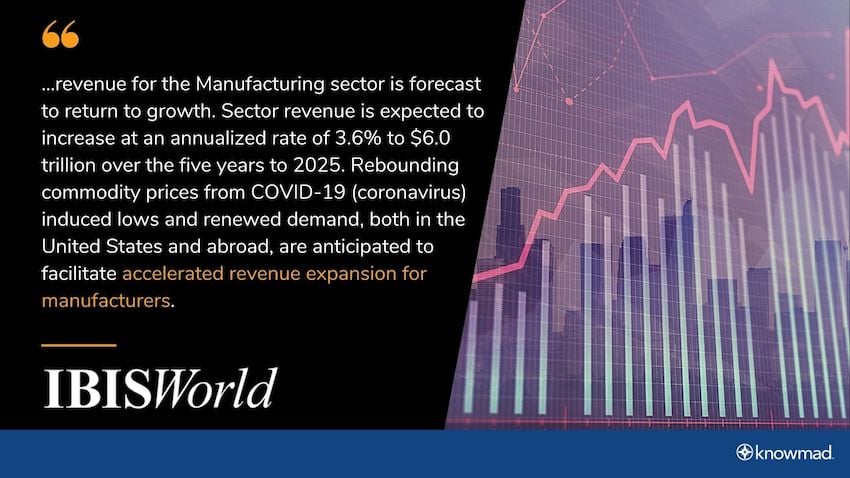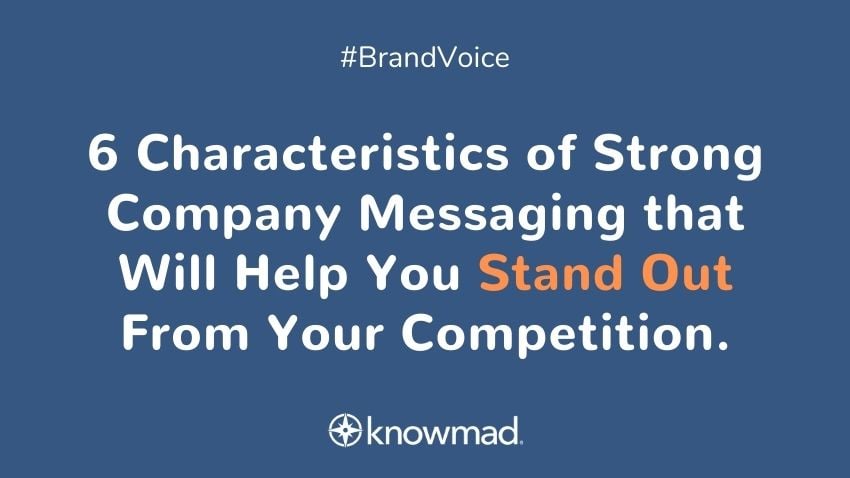Digital marketing in the industrial space has moved beyond inbound marketing and omnichannel marketing. As 2020 wreaked havoc on the economy, many companies focused on investing in digital marketing to ensure their success in 2021 and beyond. Thanks to the digitization of the B2B sales process, many B2B industrial companies are investing in specific marketing trends in order to capitalize on growth in a post-COVID economy.
According to IBISWorld research, the manufacturing sector is forecasted to return to growth.

As a result of these forecasts, many companies are investing in digital marketing, leading to an increase in online competition. Thanks to options that facilitate online sales, many B2B decision-makers are comfortable with the idea of making big-budget decisions without ever meeting in person.
Industrial (B2B) and consumer (B2C) marketing strategies are very distinct. The sales cycle for consumer marketing is much shorter, and it doesn’t require as much nurturing or touch points as the B2B buying team. Due to the complexity of B2B products and services involved, an industrial marketing strategy calls for a specific approach for success.
Let’s look at the five main pillars of a successful industrial marketing strategy:
1. Define Your Brand and Brand Voice
Forbes provides a clear definition of brand: “your “brand” is what your prospect thinks of when he or she hears your brand name...Your brand name exists objectively; people can see it. It’s fixed. But your brand exists only in someone’s mind.”
Most established companies already have a brand; it’s how you set yourself apart from the competition. Without a brand, you risk getting lost in a sea of companies similar to yours and limiting your growth potential. Branding is supposed to build trust and credibility around your business, giving your customers a reason to remember, associate, and relate to your organization.
Brand Voice helps your company communicate with the people you’re trying to reach. Brand voice in B2B marketing can be a challenge; it’s not easy to give an industrial company a brand voice that speaks to prospects without sounding salesy or patronizing.
Fortunately, there are plenty of guides available to help you perfect your brand voice. Start with our guide:
2. Website Design for Lead Generation and Sales
Out of 3,400 global marketers in HubSpot’s State of Marketing Report, the majority identified lead generation as their top priority. While you can invest in the latest martech software, it’s not going to help you reach your goals if your website isn’t set up for lead generation and sales.
Creating a website that’s designed for lead generation and sales is an investment that will pay dividends for years to come - it’s a lead generation tool owned solely by your company. While there are other options, including paid advertisements with sales landing pages, paying for leads from a third party source, or social media advertising, all of those options are turned off when your ad budget is maxed out. With a website lead generation system, your source of leads continues to run with or without ads.
Click here to learn more about creating a website for lead generation and sales.
3. Choose a Digital Marketing Tactic
Digital marketing will draw prospects to your website, but not every tactic is worth the investment. In the digital space, inbound marketing can include search engine optimization, paid advertising (PPC & Retargeting), content marketing, digital PR, and social media marketing.
If you’re not sure where to begin, start with a digital marketing plan template. Organizing your plans within a template will ensure that you don’t miss anything. Once you have a template, consult with an industry expert and let them help you identify the best digital marketing tactic for your business.
4. Content for Conversations
Conversational content isn’t a new marketing concept, but many B2B companies mistake this for sales language and calls to action.
Before you identify the format and tools you’ll use to start conversations, take a close look at the content. Your sales team can help you identify the most common initial questions from prospects, giving your content team a list of priority topics. Next, you’ll need to consider where these conversation starters will live on your website. You can start with your analytics tool and identify the most popular pages on your website. Once you’ve captured a few leads with your strategy, build it out even further. If it doesn’t work, take a step back, and try again.
Digital marketing success doesn’t come from getting it right 100% of the time; it comes from thoughtful planning, measurement, and adjustments to improve results.
A conversion-focused site can incorporate any of these features:
- Instant live chat
- Click-to-call button
- Ordering forms
- Frequently Asked Questions page with a form for a specific question
- Calendar tools for scheduling meetings and bookings
5. Measurement
Marketing is a continuous endeavor that builds momentum, but if you’re not measuring the right KPIs, you won’t know what’s working and what’s not. You’ll hear lots of acronyms when marketers talk about measurement; here are a few definitions:
- KPIs - Key Performance Indicators
- ROI - Return on Investment
- CPL - Cost Per Lead
KPIs
Key performance indicators measure the number of website visitors, website visitors who call you or fill out a form (conversions), engagement, impressions, and other metrics that provide month-to-month comparisons of website activity.
ROI
Return on Investment is a comparison between the money that your company spends on marketing vs the revenue that it generates as a result of marketing. Without clear KPIs, it’s impossible to determine ROI from digital marketing.
HubSpot offers formulas and examples to help you determine your digital marketing ROI. Most digital marketing efforts won’t generate immediate ROI, but some methods are faster than others. Consult with your marketing agency if you’re concerned about the timelines for ROI.
CPL
Cost-per-lead isn’t something that most marketing teams track, but when you’re investing thousands of dollars per month in a digital marketing plan, it’s important to track cost-per-lead. With PPC campaigns, an experienced manager will work to reduce the CPL over time. SEO tends to deliver a lower CPL than other forms of digital marketing, but it can take longer to deliver ROI.
Setting the right KPIs is a critical part of any digital marketing plan; work with a marketing team or agency who has a plan in place for measurement on a monthly or quarterly basis.
As the B2B sales process continues to evolve, the need to invest in digital marketing efforts for your industrial company will grow. The topics discussed in this article are intended to be a guide for your marketing efforts:
- Define Your Brand and Brand Voice
- Design Your Website For Lead Generation
- Choose a Digital Marketing Tactic
- Create Conversational Content
- Measure Your Efforts with Data
With longer sales cycles and complex products, you’ll need a well thought out digital strategy. The 5-pronged approach outlined in this article gives you a strong foundation to your industrial marketing strategy.
.webp?width=900&height=548&name=wyatt-mobile%20copy%20(2).webp)


